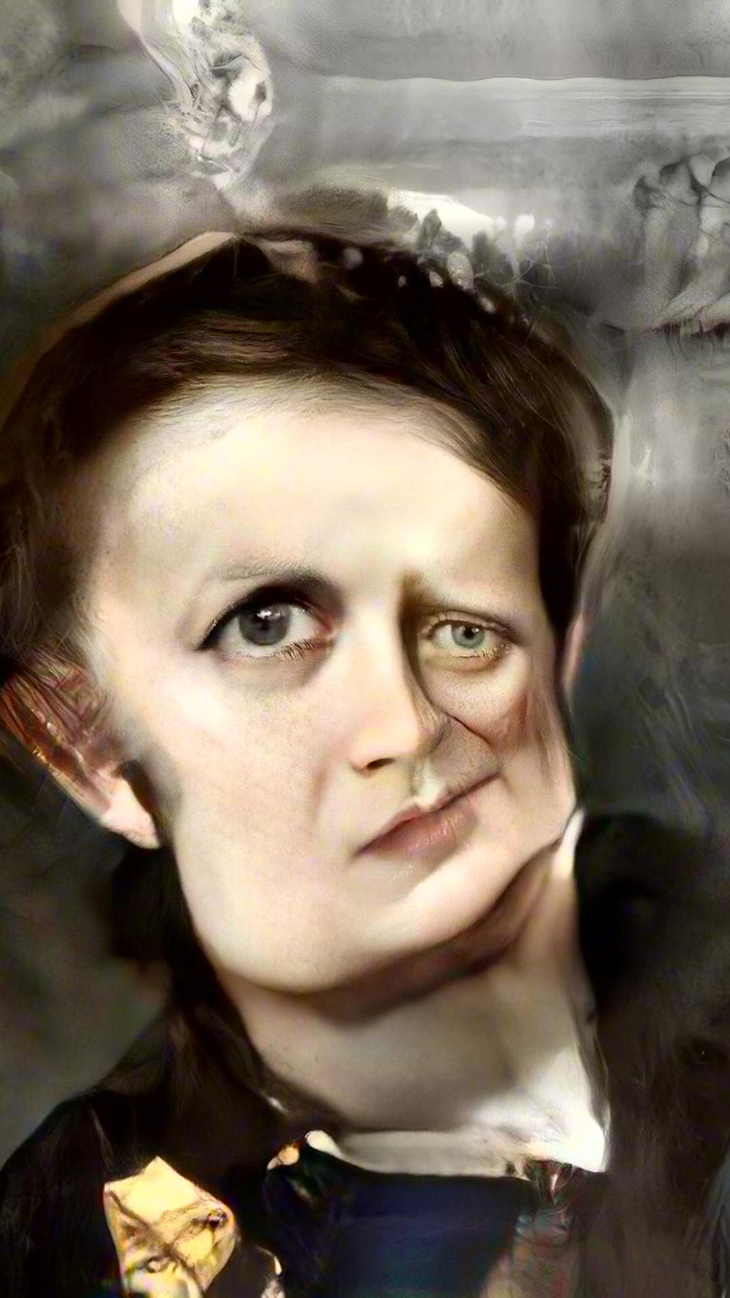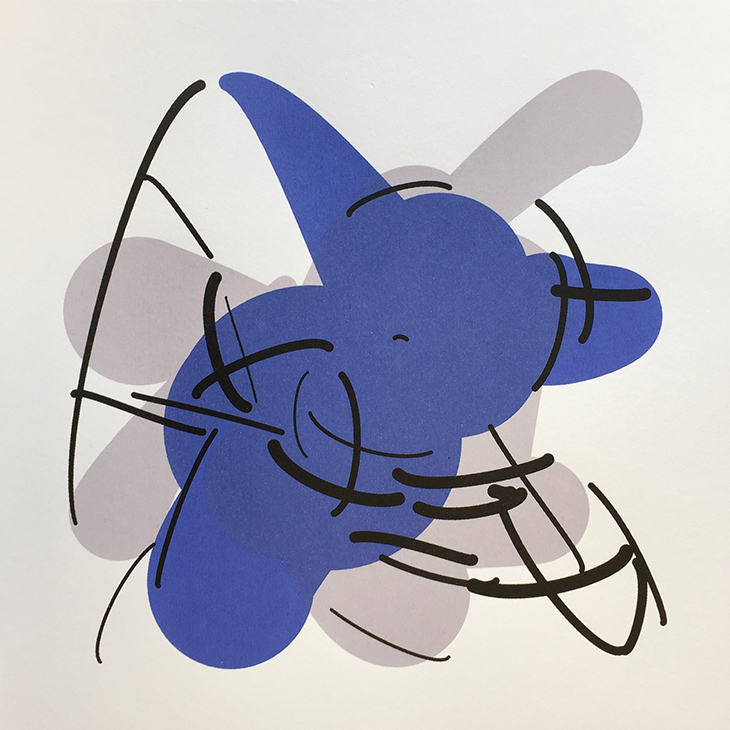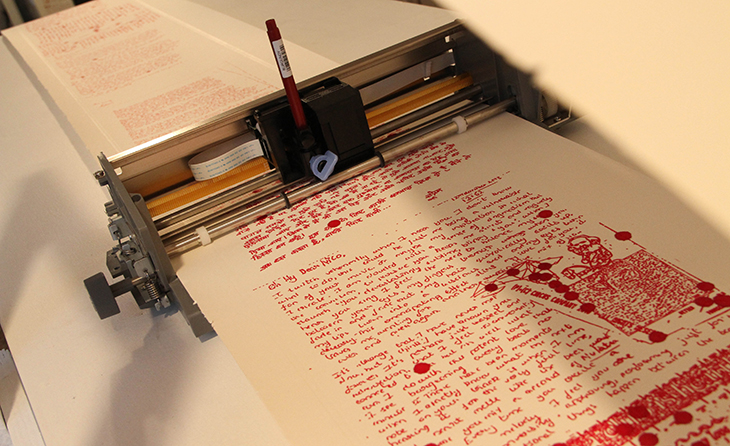In the essay ‘Art in the Time of the Artificial’ (1998), Frieder Nake, a pioneer of computer-generated art, describes the bewilderment surrounding Georg Nees’s works at the first exhibition of computer art in Stuttgart in 1965. Uneasy questions confronted Nees’s drawings, created using a plotter following a programmed pattern to generate geometrical figures – was this authentic art? Who should be considered its author? We still appear to be asking the same questions today; the image itself is often outweighed by the process that constructs it.
In a moment when the information we consume and our patterns of digital behaviour are largely influenced by algorithmic processes, why does AI (artificial intelligence) art still confound us? Perhaps because the algorithmic image as aesthetic object takes us beyond the capacity of AI as a functional tool, turning it into a medium itself. The more interesting question might not be about who creates the art but why we consider it to be art in the first place. How do we surpass the obsession with whether AI art can convince us of its humanness and instead consider its larger implications on what we value as creativity? Unfortunately, the commercial positioning of AI art still emphasises spectacle and kitsch.

79530 Self Portraits (still; 2018), Mario Klingemann. Courtesy Nature Morte
So, when ‘Gradient Descent’, an exhibition at Nature Morte gallery in New Delhi (until 15 September) presented itself as ‘the first ever art exhibition in India to include artwork made entirely by artificial intelligence’, I was slightly wary. The exhibition, curated by the research collective 64/1, brings together coders and artists like Mario Klingemann, Memo Akten, Tom White and Anna Ridler, for a mini-survey of the visual possibilities of neural-network AI, which seeks to recreate the mechanics of cognition in the human brain. Klingemann, probably the most recognisable of the group, has been building these kinds of programmes for years, which he ‘trains’ on massive amounts of visual data to eventually create an output that, in the work on view here, continually merges his own webcam self-portraits with those of Old Masters. The video is titled 79530 Self Portraits: each successive image mutates to integrate the previous one at a giddy pace, facial features floating in a distorted, Baconesque world.
Tom White’s Perception Engines project plays with classification systems and idioms of abstraction. His radial, blob-like prints, produced by feeding procedural algorithmic drawings through another algorithm, bring the AI into conversation with itself, a complex mimesis of dialogue that almost approaches what human creativity might look like in the mirror of artificial intelligence. London-based Jake Elwes takes this dialogue further in Closed Loop, a two-channel video from 2017 that distills the circuitry of perception. An indistinct, pastel image, created by training a generative neural network on 14.2 million photographs, appears on one screen while words, similarly drawn from a huge dataset, assemble as a descriptive response on the other. The image then slowly reconfigures to match the language in an exchange that is both intimate and enthralling – and observing it vaguely voyeuristic.

Electric Fan , from the series Perception Engines (2018), Tom White. Courtesy Nature Morte
These works push the limits of vision, delineating how we tend to assign meaning to an art object, and bringing into question the possibility of a kind of creative production that can exist outside the human framework, or as an extension of it. Elsewhere, however, ‘Gradient Descent’ gets tangled in the final product and the shock of the machine, with artworks that self-consciously remind us that they were created using AI. Memo Akten’s Deep Meditations (2018) falls into this trap. Using photographs from Flickr and the Google Art Archive, the work is an interesting demonstration of style transfer – where the machine learns the template of one (or in this case, tens of thousands of) images and blends this into a new image – at work, but is a hollow display of AI’s most basic capabilities.
The gallery has valid commercial reasons for this curatorial farrago, with the rapid rise of financial interest in and visibility of AI art over the last couple of years. This autumn, Christie’s will become the first auction house to sell an algorithmic work. IBM and Google have invested millions into labs to explore the creative capabilities of neural networks. Last year, MoMA looked back to the beginnings of machine-made art with the exhibition ‘Thinking Machines: Art and Design in the Computer Age, 1959–1989’, while the Grand Palais in Paris recently concluded its vast, immersive exhibition on ‘Artists & Robots’.

Emotive Sounds of the Electric Writer (2013–15), Nandita Kumar. Courtesy Kiran Nadar Museum of Art
However, this fascination with the final image and the complex functionalities of AI can often make us forget the viewer in the process. As critic Mike Pepi put it in Frieze: ‘Art, after all, is little more than institutionalized agreement among one or more subjects to call something as such […] Its only unifying property, then, are its human subjects.’ How can AI art transcend this agreement, and bring the viewer into its fold in more meaningful ways?
At an exhibition of new media art at the Kiran Nadar Museum of Art, located a few kilometres from Nature Morte, I saw two such works that attempted to do exactly this. Sonia Khurana’s imposing House Anatomy (vertical spin) (2014), a stack of screens playing a loop of ant colonies moving in algorithmic patterns. The viewer’s body is brought into sharp contrast with the pictures onscreen, creating an agitated experience of scale. In Nandita Kumar’s Emotive Sounds of the Electric Writer project (2013–15), viewers were invited to write letters that were converted into inkblots, in turn fed through an algorithm that transformed them into a musical score. Kumar’s work thus considers the multisensorial implications of digital and analogue forms of correspondence, keeping the human at the centre of its technology.
AI art is at a precipice, where we are still largely uncertain about its role as tool, medium, or independent creative entity. The acceptance of AI will be contingent on our own dynamic understanding of changing aesthetics in the digital age, of which spectacle may ultimately be an indelible part.

AI art is on the rise – but how do we measure its success?
Closed Loop (2017), Jake Elwes Courtesy Nature Morte
Share
In the essay ‘Art in the Time of the Artificial’ (1998), Frieder Nake, a pioneer of computer-generated art, describes the bewilderment surrounding Georg Nees’s works at the first exhibition of computer art in Stuttgart in 1965. Uneasy questions confronted Nees’s drawings, created using a plotter following a programmed pattern to generate geometrical figures – was this authentic art? Who should be considered its author? We still appear to be asking the same questions today; the image itself is often outweighed by the process that constructs it.
In a moment when the information we consume and our patterns of digital behaviour are largely influenced by algorithmic processes, why does AI (artificial intelligence) art still confound us? Perhaps because the algorithmic image as aesthetic object takes us beyond the capacity of AI as a functional tool, turning it into a medium itself. The more interesting question might not be about who creates the art but why we consider it to be art in the first place. How do we surpass the obsession with whether AI art can convince us of its humanness and instead consider its larger implications on what we value as creativity? Unfortunately, the commercial positioning of AI art still emphasises spectacle and kitsch.
79530 Self Portraits (still; 2018), Mario Klingemann. Courtesy Nature Morte
So, when ‘Gradient Descent’, an exhibition at Nature Morte gallery in New Delhi (until 15 September) presented itself as ‘the first ever art exhibition in India to include artwork made entirely by artificial intelligence’, I was slightly wary. The exhibition, curated by the research collective 64/1, brings together coders and artists like Mario Klingemann, Memo Akten, Tom White and Anna Ridler, for a mini-survey of the visual possibilities of neural-network AI, which seeks to recreate the mechanics of cognition in the human brain. Klingemann, probably the most recognisable of the group, has been building these kinds of programmes for years, which he ‘trains’ on massive amounts of visual data to eventually create an output that, in the work on view here, continually merges his own webcam self-portraits with those of Old Masters. The video is titled 79530 Self Portraits: each successive image mutates to integrate the previous one at a giddy pace, facial features floating in a distorted, Baconesque world.
Tom White’s Perception Engines project plays with classification systems and idioms of abstraction. His radial, blob-like prints, produced by feeding procedural algorithmic drawings through another algorithm, bring the AI into conversation with itself, a complex mimesis of dialogue that almost approaches what human creativity might look like in the mirror of artificial intelligence. London-based Jake Elwes takes this dialogue further in Closed Loop, a two-channel video from 2017 that distills the circuitry of perception. An indistinct, pastel image, created by training a generative neural network on 14.2 million photographs, appears on one screen while words, similarly drawn from a huge dataset, assemble as a descriptive response on the other. The image then slowly reconfigures to match the language in an exchange that is both intimate and enthralling – and observing it vaguely voyeuristic.
Electric Fan , from the series Perception Engines (2018), Tom White. Courtesy Nature Morte
These works push the limits of vision, delineating how we tend to assign meaning to an art object, and bringing into question the possibility of a kind of creative production that can exist outside the human framework, or as an extension of it. Elsewhere, however, ‘Gradient Descent’ gets tangled in the final product and the shock of the machine, with artworks that self-consciously remind us that they were created using AI. Memo Akten’s Deep Meditations (2018) falls into this trap. Using photographs from Flickr and the Google Art Archive, the work is an interesting demonstration of style transfer – where the machine learns the template of one (or in this case, tens of thousands of) images and blends this into a new image – at work, but is a hollow display of AI’s most basic capabilities.
The gallery has valid commercial reasons for this curatorial farrago, with the rapid rise of financial interest in and visibility of AI art over the last couple of years. This autumn, Christie’s will become the first auction house to sell an algorithmic work. IBM and Google have invested millions into labs to explore the creative capabilities of neural networks. Last year, MoMA looked back to the beginnings of machine-made art with the exhibition ‘Thinking Machines: Art and Design in the Computer Age, 1959–1989’, while the Grand Palais in Paris recently concluded its vast, immersive exhibition on ‘Artists & Robots’.
Emotive Sounds of the Electric Writer (2013–15), Nandita Kumar. Courtesy Kiran Nadar Museum of Art
However, this fascination with the final image and the complex functionalities of AI can often make us forget the viewer in the process. As critic Mike Pepi put it in Frieze: ‘Art, after all, is little more than institutionalized agreement among one or more subjects to call something as such […] Its only unifying property, then, are its human subjects.’ How can AI art transcend this agreement, and bring the viewer into its fold in more meaningful ways?
At an exhibition of new media art at the Kiran Nadar Museum of Art, located a few kilometres from Nature Morte, I saw two such works that attempted to do exactly this. Sonia Khurana’s imposing House Anatomy (vertical spin) (2014), a stack of screens playing a loop of ant colonies moving in algorithmic patterns. The viewer’s body is brought into sharp contrast with the pictures onscreen, creating an agitated experience of scale. In Nandita Kumar’s Emotive Sounds of the Electric Writer project (2013–15), viewers were invited to write letters that were converted into inkblots, in turn fed through an algorithm that transformed them into a musical score. Kumar’s work thus considers the multisensorial implications of digital and analogue forms of correspondence, keeping the human at the centre of its technology.
AI art is at a precipice, where we are still largely uncertain about its role as tool, medium, or independent creative entity. The acceptance of AI will be contingent on our own dynamic understanding of changing aesthetics in the digital age, of which spectacle may ultimately be an indelible part.
Unlimited access from just $16 every 3 months
Subscribe to get unlimited and exclusive access to the top art stories, interviews and exhibition reviews.
Share
Recommended for you
A portrait of the artist’s studio – in virtual reality
The Zabludowicz Collection’s new virtual reality exhibition space opens with a work that tests the limits and possibilities of the technology
How conservators are fighting the battle against built-in obsolescence
It’s never too early to begin preserving time-based media art
Can artificial intelligence really identify artistic influence?
Scientists have developed an algorithm that identifies visual affinities between paintings. Are we all out of a job?